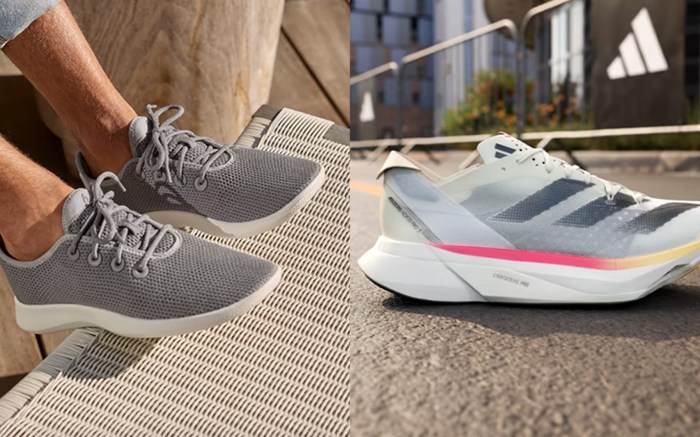Nike‘s innovation woes have been well documented by brand execs, market watchers and sneaker consumers alike. However, with the athletic giant releasing its third quarter earnings Thursday afternoon, conversation has escalated.
“While we remain long-term optimistic on NKE due to their long track record of success, we’ve become incrementally cautious short term due to a frustrating lack of product innovation, and we think it’s becoming clearer that the ‘Consumer Direct Acceleration’ strategy was a mistake,” Wedbush Securities wrote in a note Monday. “Essentially, the company’s original pre-COVID ‘Consumer Direct’ plan was doing just fine, but by ‘accelerating’ the strategy in 2020, they focused too much on where they were selling and lost focus of what they were selling.”
Matt Powell, advisor at Spurwink River and senior advisor at BCE Consulting, believes the definition of innovation — when it comes to Nike’s specific struggles — requires further explanation.
Watch on FN
“I’m not focused on new technology because I think we’re at the apogee of that. I am focused on innovation in terms of new products, new lines, new ideas,” Powell said. “What happened with Nike, and lots of brands during the pandemic, was they made a decision to play it very safe. They essentially shut down their innovation engine and said, ‘We’re not going to come out with new product because it’s risky. We’re going to lean hard on our tried-and-true, top best sellers because those are the safest shoes we have in the mix.'”
Powell — citing the pandemic success of Hoka, On, Brooks and Asics — believes that was an incorrect strategy for Nike to take.
Russ Bengtson, longtime sneaker writer and author of “A History of Basketball in Fifteen Sneakers,” suggested that Nike focused so much on the past that it has neglected its future.
“The innovation is still there. The Air Jordan 38 is a technically-advanced, cool shoe. The stuff they’re doing in running is incredible. But for someone buying sneakers just to buy sneakers, they’re going to go back to the Air Max 90, the Air Max 95, the Air Jordan 1, the Air Jordan 3. They’re not even considering the new stuff,” he explained. “I don’t think I’ve seen a single person wearing the LeBron 21. The shoe that’s got attention is the Book 1, but it’s because it’s referencing old product.”
He continued, “They’ve done such an incredible job selling and reselling the old stuff, I don’t know if they’ve forgotten how to push the new stuff or if selling the new stuff hasn’t mattered. The only way for them to get back to what they were is to get people to care about the new stuff again.”
Struggling With Sameness
“A lot of the current innovation we see in Nike product feels like a version of something we’ve already seen before, as opposed to something that’s brand new,” said TV host and content creator Jacques Slade.

The most recent example of this is the Air Max Dn, a polarizing silhouette that Nike revealed in February. The shoe features Dynamic Air, which is a dual-chamber, four-tubed unit designed with comfort and a smooth stride in mind. The sneaker will release on March 26, affectionately referred to by sneakerheads as Air Max Day. It will retail for $160.
At the time, Nike said in a statement that it set out to create “something Air Max lovers haven’t seen before” in terms of the shoe’s look.
But Slade argued that wasn’t really the case.
“There was a shoe from the early 2000s, a basketball shoe, with essentially the same tech. They just called it something different,” Slade said. “The Air Max Dn is not necessarily something new, it just feels like a version of something from years ago, but they’re billing it as something new.”
The shoe Slade referenced was the Nike Air P-Phaze, an early 2000s basketball silhouette featuring Tubular Air. Other shoes from that era used similar tech, such as the Air Max 2002.

What Was Nike’s Last Great Innovation?
The sneaker community doesn’t often agree on much, however Bengtson, Slade and Powell all believe Nike’s last great tech advancement was Flyknit, which debuted in 2012. They also agreed on what was Nike’s last great innovative shoe, the Air VaporMax, which hit the market in 2017.
“VaporMax was the last big moment when I think about like Nike doing something different. It was like, ‘Holy s–t, look at those Air bubbles,'” Slade said. “It made so much sense. It felt like this is what Air should be, what it’s supposed to look like. Everyone was fascinated with VaporMax when we first saw it. That sort of energy and the thing that captures the imagination of the consumer, they haven’t been able to do that [again].”
Those moments of excitement, however, aren’t missing from the marketplace. They’re just coming from Nike’s competitors.
For instance, basketball — a category Nike has long dominated — has seen increased competition in recent years from rivals Adidas and Puma.
With Adidas, NBA star Anthony Edwards’ first signature shoe, the AE 1, has won consumers over for both its design and the corresponding promotional efforts that showcased his ever-confident personality. And with Puma, the brand has notably made inroads with younger consumers specifically through NBA star LaMelo Ball’s signature franchise (which are also a hit on the resale market), as well as the line for rookie Scoot Henderson.
“When I look at the Anthony Edwards [Adidas AE 1] shoe, or even the [James] Harden, that stuff stands out. And [with Puma], those are not elite tier price point product — the Scoot [Zeros] shoe is $100, LaMelo is $125,” Bengtson said. “Nike had that for a while, they’re just in a weird spot right now because Kyrie [Irving’s shoes] certainly filled that for them. The Kyrie shoe was hugely popular among kids and it had that space that the Anthony Edwards shoe does. The [Nike] Ja Morant shoe slid into that spot [with Irving’s departure from the brand], but then he had his legal thing and then he got hurt, so it’s tough to sell him right now.”
For context, Nike ended its relationship with Irving in December 2022 shortly after the NBA star posted a link to the film “Hebrews to Negroes: Wake up Black America” on his social media. Irving has since moved on to Anta and his first signature shoe with the brand, the Kai 1, released at the start of this month.
As for Morant, in June 2023, the Memphis Grizzlies star was suspended by the NBA for 25 games without pay for conduct detrimental to the league. The decision stemmed from two separate instances of the athlete flashing a gun on social media.
Now, as Bengtson noted, Nike’s top players are LeBron James, who is 39, and Kevin Durant, who is 35. “If I’m a kid and I have money to spend on sneakers, I’m not even looking at a $200 LeBron — especially if a Jordan 3 is $200 and that’s going to get a lot more props from your peers.”

As for running, the sneaker market’s largest category — and where Nike got its start — Slade said he has been impressed with the inroads On has made.
“I never imagined a world where a running brand would capture the market the way that On has when Nike is so rooted in running,” Slade said. “I travel a lot. I go to a ton of golf tournaments. I’m in airports and I’m in the grocery store and I see more On than anything else. And On’s shoes aren’t cheap, they’re not budget kicks that are mad comfy. Their price is along the same lines as Nike product. How was On able to capture the imagination of this audience when that should be easy money for Nike?”
Despite his criticism, Bengtson believes some of Nike’s struggles could be fixed fairly quickly.
“If a company wants something to hit, you need the right athlete, an interesting shoe and a killer marketing campaign,” he said. “You need something to make it seem larger than life and to push the shoe into so many corners of the universe before even releases.”
The sneaker expert was critical of all brands, not just Nike, for essentially replacing effective marketing campaigns with social media strategies.
“The reason Air Jordan took off, the reason Penny [Hardaway] took off, the reason [Charles] Barkley took off is Nike made these insanely amazing ads. Your average kid on TikTok can’t create that,” Bengtson said.
One way Nike can recreate that magic? With NBA star Devin Booker.
“Build a huge campaign around Devin, spend money for a Super Bowl commercial, put it on at the highest level,” Bengtson said. “It shouldn’t matter if the TV audience is fragmented. That’s the highest level you can place that stuff, so go back to that because it’s going to spread down. If you create the greatest TikTok video ever, it’s not going to wind up on national TV. It doesn’t flow the other way.”
Could We See an Innovation Turnaround?
With Nike’s ongoing product woes and current marketplace challenges, industry analysts have been critical of the company’s leadership.
“Today, it appears as if consultants, rather than Nike experts are leading strategy decisions, senior leaders are too dogmatic, and do not welcome all opinions,” Williams Trading analyst Sam Poser wrote in a note Monday. “Financial goals are leading merchandising decisions, and many of those driving the direction of the company are using spreadsheet, rather than the educated gut, with strict parameters that led Nike to become a $50B company.”
Those questionable merchandising decisions are not lost on Slade.
“There is a possibility that the goals or the guideposts are different now,” he said. “[CEO] John [Donahoe] is different from [prior CEO and current executive chairman] Mark [Parker] who was a different from [Nike co-founder and former CEO] Phil [Knight] — but Phil and Mark seem to be closer in step than Mark is to John. That plays into the conversation of what you see from the brand, its imaging and messaging.”
What’s more, insiders believe Nike’s recent layoffs could have an impact on what consumers see on retail shelves. In February, the company revealed it is laying off 2 percent of its workforce, two months after it announced it was taking steps to “streamline” the organization to save up to $2 billion in costs over the next three years.
“The brand has lost a lot of core talent that had history with the brand, that could speak to culture, to innovation, to styling of the brand in an authentic way. Corporate culture is very important, and that culture is starting to slip away at Nike. The people that are there now almost have culture secondhand,” Slade said.
With multiple seasons of questionable product releases, Powell doesn’t believe a quick turnaround is possible.
“We started talking about [innovation woes] a couple of conference calls ago, so let’s assume that there is three to six months of energy here. That means we’re still a year away from seeing significant new product,” Powell explained. “Can they fast track a few things? Sure, and I would expect to see that. But as I’m talking to retailers, I’m not hearing that there’s some significant new product coming down the pipeline in the short term.”
About the Author
Peter Verry is the Senior News and Features Editor for Athletic and Outdoor at Footwear News. He oversees coverage of the two fast-paced and ultracompetitive markets, which includes conducting in-depth interviews with industry leaders and writing stories on sneakers and outdoor shoes. He is a lifelong sneaker addict (and shares his newest purchases via @peterverry on Instagram) and spends most of his free time on a trail. He holds an M.A. in journalism from Hofstra University and can be reached at peter.verry@footwearnews.com.


